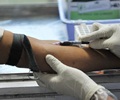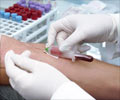Hepatitis B and C infections were found to increase the risk for Parkinson’s disease, providing an insight into the mechanism of disease development
- Hepatitis B and C infections occur in more than 290,000 people in India every year and these infections are shown to be associated with an increased risk for Parkinson’s disease
- People with hepatitis B infections have a 76% higher risk of getting Parkinson’s
- People with hepatitis C infections are at a 51% higher risk of getting Parkinson’s
- 850,000 to 2.2 million people in the U.S have chronic hepatitis B viral infection
- 2.7 to 3.9 million people are affected by chronic hepatitis C
- 290,000 cases of acute viral hepatitis occurred in 2013
- Hepatitis B virus is the second most common cause of viral hepatitis in India
- There are more than 40 million hepatitis B virus carriers in India
- 46% of HBV and 38% of HCV virus transmission in India is through infected needles
Mode of Transmission
The hepatitis B and C viruses are spread through infected blood as well as through other body fluids of the infected individual. The viruses can also spread through unprotected sex, sharing needles, while getting a tattoo, at the salon where unsterilized razors are used or even while using the toothbrush of an infected individual. Apart from these modes of transmission, hepatitis C virus can also spread from an infected mother to her child during pregnancy.Dr. Julia Pakpoor, the study author from The University of Oxford said, that since the development of Parkinson's disease is complex and involves both environmental and genetic factors, it is possible that there are many ways by which hepatitis infections could be associated with Parkinson’s; it could be the infection itself, the treatment provided for the infection or that the same people were prone to both the conditions. An understanding of this mechanism will provide key insights into the development of Parkinson’s disease.
Hepatitis and Parkinson’s
The hospital records were examined from a British database and the scientists identified people who were infected for the first time with hepatitis C, hepatitis B, chronic active hepatitis, autoimmune hepatitis and HIV during the period of 1999-2011. The medical records of these people were then compared with people who had comparatively minor health issues like knee replacement surgery, cataract surgery or bunions. Finally, those who developed Parkinson’s at later stages in their life from among the participants were identified.The participants comprised
- nearly 22,000 people with hepatitis B infection
- 48,000 people with hepatitis C infection
- 6,000 people with autoimmune hepatitis
- 4,000 people with chronic active hepatitis
- nearly 20,000 people with HIV
- 6 million people with minor conditions
- There was a 76% higher chance of people with hepatitis B to get Parkinson’s disease when compared to people with minor ailments.
- There was a 51% higher chance of people with hepatitis C to get Parkinson’s than people in the control group.
- 44 people who had hepatitis B developed Parkinson’s disease. In the general population, only 25 cases of Parkinson’s disease would occur for the same sample size.
- 73 people who had hepatitis C developed Parkinson’s disease. In the general population, only 49 cases of Parkinson’s disease would occur for the same sample size.
- There was no increase in the rate of Parkinson’s disease among people with chronic active hepatitis, autoimmune hepatitis and HIV.
The current study findings concur with earlier studies conducted in terms of an association between hepatitis C and Parkinson's disease alone; however, there was no association with hepatitis B. A study by Wu WY and colleagues titled “Hepatitis C virus infection: a risk factor for Parkinson's disease”, says that the hepatitis C virus could invade the central nervous system with an increased expression of inflammatory biomarkers. The study found that the release of the inflammatory cytokines could have led to the development of the disease.
In another population-based study conducted by Tsai HH and colleagues titled “Hepatitis C virus infection as a risk factor for Parkinson disease: A nationwide cohort study”, infection with hepatitis C virus was found to be significantly associated with Parkinson’s disease.
Considering the increased risk for Parkinson’s disease, it is important to identify the symptoms of hepatitis C and B viral infections early and to avail treatment before there is a significant increase in inflammatory biomarkers in the central nervous system, which could lead to Parkinson’s disease.
Symptoms of Hepatitis B and C Virus Infection
The symptoms may take one or two months after the initial infection to become evident. Many people fight the infection before the symptoms set it.- Fever
- Sore muscles
- Tiredness
- Dark urine
- Poor appetite
- Nausea
- Itchy skin
- Joint pain
- Jaundice- yellowing of the eyes and skin
- Hepatitis in India: Burden, Strategies and Plans - (http://ncdc.gov.in/writereaddata/linkimages/NewsLtr0103_20146480274026.pdf)
- Hepatitis B and C may be linked to increased risk of Parkinson's disease - (https://www.ncbi.nlm.nih.gov/pubmed/25608223)
- Hepatitis C virus infection: a risk factor for Parkinson's disease - (https://www.ncbi.nlm.nih.gov/pubmed/26701382)
- Hepatitis C virus infection as a risk factor for Parkinson disease: A nationwide cohort study - (http://hepc.liverfoundation.org/diagnosis/symptoms-of-hep-c/)
Source-Medindia
















